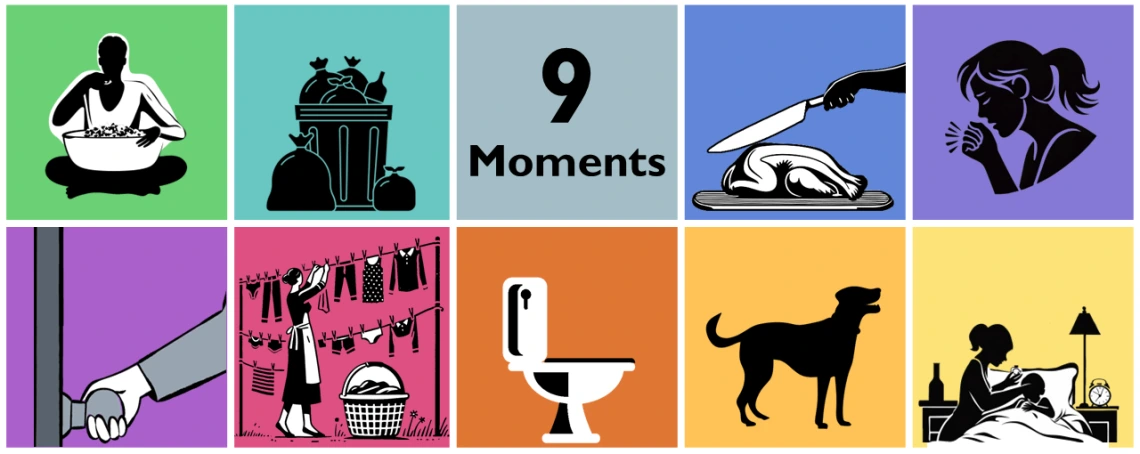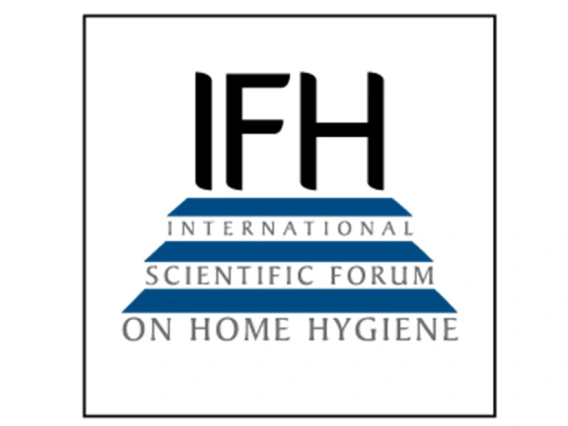
The 9 Moments for Hygiene emphasize key situations where practicing Targeted Hygiene can significantly reduce the spread of harmful microbes, breaking the chain of infection and protecting health. By focusing hygiene efforts on these critical moments, we can prevent the transmission of pathogens without disrupting exposure to beneficial microbes essential for our health. This approach supports a proactive, informed hygiene practice that helps prevent infections while respecting the balance of our microbiome.
The 9 Moments for Hygiene
- Before handling ready-to-eat food or eating with hands
Practicing hygiene before preparing or consuming food prevents harmful microbes from entering our mouths and digestive systems, reducing the risk of illness. - Handling and discarding waste
Waste often harbors pathogens that can spread through contact. Properly handling and disposing of waste with hygiene in mind prevents these microbes from contaminating hands, surfaces, and other areas in the home. - After handling raw ingredients
Raw foods, particularly meats, often carry bacteria that can cause illness if spread to other foods or surfaces. Washing hands and cleaning surfaces after handling raw ingredients prevents cross-contamination and foodborne illnesses. - Coughing, sneezing, and nose blowing
Respiratory secretions contain pathogens that can be easily spread to others. Practicing hygiene after sneezing, coughing, or blowing your nose helps prevent respiratory infections from spreading, especially in shared spaces. - Contact with high-touch surfaces
Commonly touched surfaces (like doorknobs, light switches, and cell phones) can accumulate harmful microbes from frequent handling. Cleaning these surfaces regularly and practicing hand hygiene after contact reduces the risk of germ transfer. - Handling and laundering 'dirty' clothing or linens
Used clothing, towels, and linens can harbor pathogens, especially when exposed to bodily fluids or environmental contaminants. Washing hands after handling dirty laundry and maintaining cleanliness in laundry routines help contain potential sources of infection. - Using the toilet or changing a diaper
Bodily waste can contain harmful microbes, which can easily be spread if proper hygiene isn’t followed. Thorough handwashing after using the toilet or changing diapers prevents the transmission of fecal-oral pathogens. - Caring for domestic animals
Pets and animals can carry microbes that are harmless to them but may cause illness in humans. Practicing hygiene after feeding, grooming, or cleaning up after pets prevents these pathogens from spreading within the household. - Caring for infected family members
When family members are ill, they may shed pathogens that can easily spread to others. Using targeted hygiene practices when caring for sick individuals helps prevent infections from spreading to other family members and supports recovery in a clean environment.
These moments highlight when hygiene practices are essential to maintaining health in the home. By focusing on these specific times, Targeted Hygiene empowers individuals to prevent infections thoughtfully and effectively.
Learn More: IFH Resources

RSPH and IFH call for a clean-up of public understanding and attitudes to hygiene
Explore a feature article by Professor Sally Bloomfield (IFH-UK) in Perspectives in Public Health, which addresses public confusion around hygiene and cleanliness, and highlights the importance of targeted hygiene practices to break the chain of infection and combat antibiotic resistance.


